We wish to offer an analysis of the The Arrow and the Song by Henry Wadsworth Longfellow. First, we will look at rhyme, meter and form. Second, we will offer an approximate line by line analysis looking for possible literary devices and carefully examining the lyrics of the poem. Finally, we’ll state our interpretation as far as the poem’s ultimate meaning is concerned—that will constitute our summary.
We’ll briefly note first that The Arrow and the Song was written by Henry Wadsworth Longfellow on October 16, 1845. The poem was composed and written while Longfellow had his back to the fire and was preparing for church. He described the poem as coming to him as fast as an arrow. The poem comes very close to being an improvisation.
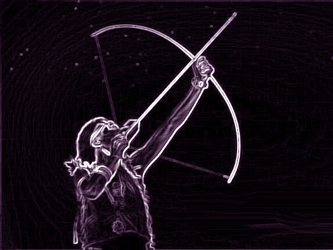
Rhyme, Meter, and Form in The Arrow and the Song
The Arrow and the Song by Henry Wadsworth Longfellow is made up of three stanzas, each four lines long. Each line is either eight or nine syllables long and rhymes with the last–so that there are a total of eight couplets.
Parallelism is important in the poem. The first and second stanza strongly mirror each other grammatically—and, in fact, share an identical line. In each of the first two stanzas, the narrator takes an action, and then states he could not know the consequences of this action. He then explains why he could not.
The final stanza reestablishes this parallelism of the previous two stanza within a single stanza. The first two lines of the final stanza conclude the actions begun in the first stanza, while the second two lines conclude the actions begun in the second stanza.
The parallelism presented here suggests that we are perhaps supposed to be making a comparison and contrast between two different actions both of which bear consequences. So this is a poetic device of sorts.
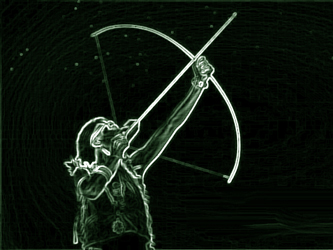
Walkthrough of The Arrow and the Song
Here we will present each stanza from The Arrow and the Song by Henry Wadsworth Longfellow, and then make as many points as possible about them. While this might appear excessive, as much as possible, we want readers to make up their own minds about the poem—so our goal is to provide as much food for thought as possible.
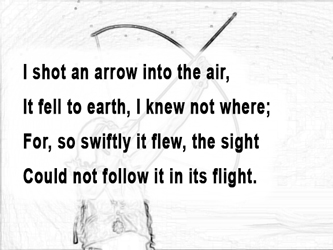
• Why does the narrator shoot an arrow into the air? Could it be the narrator was hunting? Is this simply a metaphor for some type of action the narrator took?
• Was the arrow aimed at a specific target? Can we presume the arrow missed its target? After all, it simply fell to the ground afterwards. Or could it be the case the arrow was shot on a whim without any target at all?
• An arrow is something rich in symbolism. We can potentially take the arrow as a symbol of cupid and of love. Could the narrator have been trying to obtain love? Alternatively, the arrow is a weapon—it is sharp like our wits. Could the narrator have attacked a person via some angry words?
• Note here that the arrow went so “swiftly” that the narrator could not “follow it in its flight”. We think this might suggest angry words—because we think that the narrator shot off the arrow without really thinking. The entire event happened so fast, the narrator couldn’t even be sure of what repercussions took place. Don’t angry words often escape us this way?
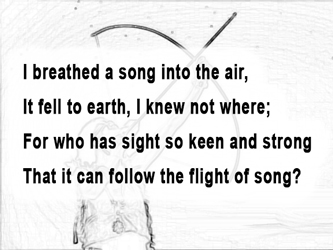
• The parallelism between the first stanza and the second stanza has already been mentioned above. We’re clearly getting some type of comparison here.
• The tone and mood of the second stanza is much gentler and smoother than that of the first.
• Note how much nicer a song is than an arrow. I mean, normally you wouldn’t even think to compare the two—but clearly in this context we must do so. Both the arrow and the song travel through the air. We lose track of both. The arrow can’t be found because it went so swiftly, but it’s totally different with the song. Who can really follow a song in the air with their eyes? We can though see a person smile as they hear the song.
• It’s fascinating to talk about the song as if it were in flight. One thinks of a bird flying—and interestingly a bird can sometimes be a target for an arrow. This brings us back to our previous question from the first stanza, was the arrow aimed at a target? Did it hit the target? And now we must ask, is the song sung for pure joy? Is the song being sung for a particular person? Is the song being sung here for a particular purpose?
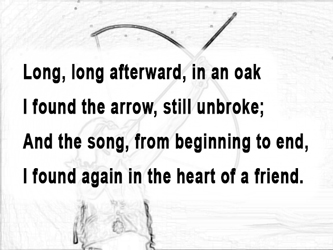
Analysis of the first two lines.
• The first two lines here are very surprising. They hit us unexpectedly and leave us in a mood of suspense. They leave us on tenterhooks as we wait for the last two lines of the poem.
• The arrow is in an oak. Again, one can think of cupid in this context. When we love someone, don’t we sometimes represent that love by carving a heart into a tree complete with an arrow—to show we’ve been struck? Could this imagery be alluding to love?
• We don’t want to get Freudian here, but both arrows and trees clearly have phallic significance here. In this sense they represent libido and passion. We don’t really think that’s the intent here, but feel this must be mentioned at least in passing.
• What’s the significance of the arrow being still unbroken? Is it still a danger? A threat?
• It’s important to remember the arrow can also represent a weapon. It’s sharp, and it hurts. The narrator shot out the arrow without ever really thinking about it, perhaps in anger. Perhaps the arrow represents words that the narrator angrily threw out and forgot about, but are still around, and still just as potent. They are sticking in the tree the way a thorn sticks in a lions paw. The suggestion then is that we should be more careful with our words.
Analysis of the second two lines
• The second two lines here are much easier to understand. The joy given off by the song has multiplied in a manner that the arrow could not. An arrow can only be one place at one time, sticking in an old tree perhaps. But what about a song? A song can multiply, and while it starts out in only one heart, it might find its way to all of our hearts.
• So could there be a simple moral here that singing a song is better than shooting an arror? Of course, these are only metaphors pointing to a deeper meaning.
Interpretation of The Arrow and the Song
We think the message of The Arrow and the Song by Henry Wadsworth Longfellow is actually fairly simple. The arrow represents careless and angry words thrown out, that while surely infertile, yielding no fruit, are capable of sticking in someone’s crawl for along time. They are not forgotten, but they are also perhaps sterile. On the other hand, words of kindness and joy, as represented via the song, are just the opposite. They can spread to everyone, just like planting a seed. In this sense, the poem is simply a short moral tale urging us to share joyful words, as opposed to getting angry and shouting at someone.
We do think other interpretations are quite possible.

Don’t forget to subscribe to ourpoetry updates, so you won’t miss any of our poem analyses or original poems!